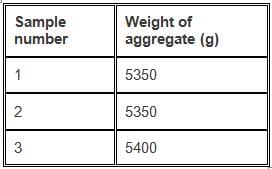Test: Highway Materials & Testing- 2 - Civil Engineering (CE) MCQ
10 Questions MCQ Test Transportation Engineering - Test: Highway Materials & Testing- 2
What is the weight of the charge used in the Los Angeles abrasion test?
The following particulars are obtained after conducting the test for angularity number:
Volume of cylinder = 3000 g
Specific gravity = 2.68

What is the angularity number for the above sample?
Volume of cylinder = 3000 g
Specific gravity = 2.68

| 1 Crore+ students have signed up on EduRev. Have you? Download the App |
There are six types of tests to conduct the adhesion test on aggregates.
The result for soundness test is expressed in terms of ______
The combined index is obtained by ______ the flakiness and elongation index.
What is used as a charge in the Dorry abrasion test?
After the abrasion test, the sample is passed through which sieve?
The aggregate impact test was conducted on a sample and the following readings were taken:
Weight of sample taken () = 350 g
Weight of sample passing 2.36 mm sieve () = 92 g
What will be the aggregate impact value for the sample?
Which of the below test – procedure pairs are matched correctly?
The polished stone value of an aggregate is reported as the ______ of the two values of ______
|
26 videos|91 docs|58 tests
|
|
26 videos|91 docs|58 tests
|





















